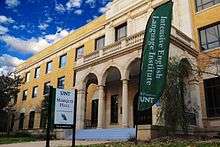University of North Texas Intensive English Language Institute
 | |
| Established | September 1, 1977 |
|---|---|
Parent institution | University of North Texas |
| Location |
Denton, Texas 33°12′32″N 97°08′52″W / 33.208845°N 97.147663°WCoordinates: 33°12′32″N 97°08′52″W / 33.208845°N 97.147663°W |
| Campus | Urban |
| Website |
international |
The University of North Texas Intensive English Language Institute (IELI) in Denton is the largest intensive English program (IEP) in North Texas, serving international students who wish to learn academic English in preparation for university studies in the United States.
History
Established in 1977, the Intensive English Language Institute is a constituent of UNT International (UNT-I), an interdisciplinary unit that serves as an exponent of globalization in higher education and a provider of leadership in support of international teaching, research, and study abroad initiatives. The Intensive English Language Institute is located in Marquis Hall on the UNT Denton campus.
Academic overview
The Intensive English Language Institute offers English courses at seven levels of proficiency, starting in Pre-1, requiring no English proficiency, and ending in level 6, which meets English language proficiency requirement for admission to UNT without having to take the TOEFL or the IELTS.[1] Additionally, undergraduate students who are enrolled in level 6 can be conditionally admitted to UNT and take six hours of courses for college credit while finishing their level 6 requirements.[1]
Fast Track to UNT
Students in this program can complete levels 5 and 6 (16 weeks of instruction) during a single 10-week summer session. Level 4 students with a 73% average may apply. Also, students with a score of at least 55 on the TOEFL iBT or at least 5.5 on the IELTS may apply.[2]
Pathway
Students in this program can be conditionally admitted to a Master's Degree program in either the College of Business or the College of Merchandising, Hospitality, and Tourism at UNT. Students in this program may begin taking Master's level courses during their final level at IELI and will remain on their original I-20.[3]
American Culture & Communication
A two-week long summer program, the American Culture and Communication program serves students 15 to 17 years old, offering 16 hours of in-class English instruction as well as experiential learning opportunities including trips to Dallas and Fort Worth and various activities in Denton.[4]
Passport to the University
This summer program, serving 15- to 17-year-old high school students, focuses on familiarizing students with the admissions processes for American universities. It includes English courses taught by UNT faculty, seminars about university admissions, tours of 4 Texas universities, and cultural activities in and around the DFW Metroplex.[5]
Pronunciation & Accent Reduction
This two-day-per-week evening course is designed to serve non-English speakers who have intermediate to advanced speaking skills, helping them to understand and master English pronunciation.[6]
Accreditation and affiliations
The Intensive English Language Institute received its initial accreditation from the Commission on English Language Program Accreditation (CEA) in 2000, making it one of the first programs in the country to do so. In 2015, IELI was reaccredited by CEA accreditation until 2025.[7] IELI is a member in good standing of the University and College Intensive English Programs (UCIEP) and EnglishUSA.[8][9]
Students
Intensive English Language Institute enrollment is composed of UNT students from 40 countries, as of Fall 2016. Most of them attend IELI under F-1 Visa status as full-time students.[7] A full-time course load is two classes per day, Monday through Friday, which amounts to 23 hours of in-class English instruction per week.[1] IELI offers small, student-centered classes, with an average class size of 12 and a maximum class size of 15.[9] The minimum application age is 17 years old.[10] As of 2016, more than 600 Intensive English Language Institute alumni are pursuing undergraduate or graduate programs at UNT, and many more are studying or working in the U.S. or in other countries.[7]
Faculty
Intensive English Language Institute instructors have master's degrees in TESOL, Applied Linguistics, Secondary Language Education, or a closely related field.
References
- 1 2 3 "Academic English," Intensive English Language Institute, University of North Texas (retrieved December 21, 2016, via international
.unt ).edu /ieli /ieli-academic-english-ieli - ↑ "Fast Track to UNT," Intensive English Language Institute, University of North Texas (retrieved December 21, 2016, via international
.unt ).edu /ieli /intensive-english-language-institute - ↑ "Pathway Programs," Intensive English Language Institute, University of North Texas (retrieved December 21, 2016, via international
.unt ).edu /ieli /pathway-programs-through-ieli - ↑ "American Culture and Communication Program," Intensive English Language Institute, University of North Texas (retrieved December 21, 2016, via international
.unt .edu /ieli - ↑ "Passport University," Intensive English Language Institute, University of North Texas (retrieved December 21, 2016, via international
.unt ).edu /ieli - ↑ "Pronunciation and Accent Reduction," Intensive English Language Institute, University of North Texas (retrieved December 21, 2016, via international
.unt ).edu /ieli - 1 2 3 UNT International Annual Report, 2015–2016, University of North Texas, pps. 3 & 8
- ↑ "Member Listing," University and College Intensive English Programs (UCIEP) (retrieved December 21, 2016, via www
.uciep ).org - 1 2 "Intensive English Language Institute, UNT," www
.englishusa , American Association of Intensive English Programs (retrieved December 21, 2016, via www.org .englishusa ).org - ↑ Listing: "UNT Intensive English Language Institute," Intensive English USA Online, Institute of International Education (retrieved December 21, 2016, via www
.intensiveenglishusa ).org